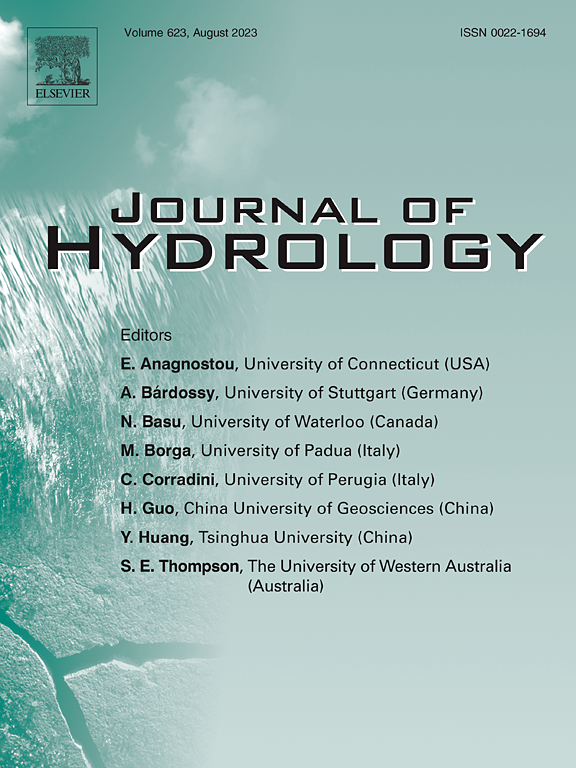A new tool for correcting the spatial and temporal pattern of global precipitation products across mountainous terrain: precipitation and hydrological analysis
IF 5.9
1区 地球科学
Q1 ENGINEERING, CIVIL
引用次数: 0
Abstract
This study primarily aims to integrate global precipitation data into hydrological models at the catchment scale, a common practice in hydrological research. Specifically, the study investigates how biased spatial and temporal patterns in precipitation data affect model performance and uncertainty. The European Meteorological Observations (EMO) and Climate Hazards Group InfraRed Precipitation with Station data (CHIRPS) global datasets are utilized as inputs for the GEOframe-NewAGE hydrological model to simulate the hydrological processes of the mountainous Aosta Valley catchment in northwestern Italy. The uncertainty of the hydrological model forced with global precipitation data is assessed using a proposed method called Empirical Conditional Probability (EcoProb). The results show that, although traditional performance metrics suggest similar outcomes for the model forced with EMO and CHIRPS, the proposed uncertainty analysis reveals higher uncertainty when CHIRPS is used as the precipitation input. To leverage all useful information in the global precipitation data, the spatial correlation of CHIRPS is combined with a subset of rain gauges using the EcoProb method to modify the EMO precipitation data. This approach enabled the integration of the advantages of EMO and CHIRPS, which offer higher temporal and spatial correlation with ground observation, respectively, into a unified precipitation product. The combined dataset, referred to as the EcoProbSet product in this study, outperformed both the CHIRPS and EMO products, reducing the uncertainty introduced into hydrological models compared to the original global datasets.
校正全球山地降水产品时空格局的新工具:降水和水文分析
本研究的主要目的是将全球降水数据整合到流域尺度的水文模型中,这是水文研究中的一种常见做法。具体而言,该研究探讨了降水数据中有偏差的时空格局如何影响模型的性能和不确定性。利用欧洲气象观测(EMO)和气候灾害组织(Climate Hazards Group)的红外降水与站点数据(CHIRPS)全球数据集作为geofframe - newage水文模型的输入,模拟意大利西北部山区奥斯塔河谷流域的水文过程。利用一种被称为经验条件概率(EcoProb)的方法对全球降水数据所迫的水文模型的不确定性进行了评估。结果表明,虽然传统的性能指标对EMO和CHIRPS强迫模型的结果相似,但所提出的不确定性分析表明,当CHIRPS作为降水输入时,不确定性更高。为了充分利用全球降水数据中的所有有用信息,将CHIRPS的空间相关性与使用EcoProb方法的雨量计子集相结合,以修改EMO降水数据。该方法能够将EMO和CHIRPS分别与地面观测具有较高时空相关性的优势整合为统一的降水产品。该组合数据集(在本研究中称为EcoProbSet产品)优于CHIRPS和EMO产品,与原始全球数据集相比,减少了引入水文模型的不确定性。
本文章由计算机程序翻译,如有差异,请以英文原文为准。
求助全文
约1分钟内获得全文
求助全文
来源期刊

Journal of Hydrology
地学-地球科学综合
CiteScore
11.00
自引率
12.50%
发文量
1309
审稿时长
7.5 months
期刊介绍:
The Journal of Hydrology publishes original research papers and comprehensive reviews in all the subfields of the hydrological sciences including water based management and policy issues that impact on economics and society. These comprise, but are not limited to the physical, chemical, biogeochemical, stochastic and systems aspects of surface and groundwater hydrology, hydrometeorology and hydrogeology. Relevant topics incorporating the insights and methodologies of disciplines such as climatology, water resource systems, hydraulics, agrohydrology, geomorphology, soil science, instrumentation and remote sensing, civil and environmental engineering are included. Social science perspectives on hydrological problems such as resource and ecological economics, environmental sociology, psychology and behavioural science, management and policy analysis are also invited. Multi-and interdisciplinary analyses of hydrological problems are within scope. The science published in the Journal of Hydrology is relevant to catchment scales rather than exclusively to a local scale or site.
 求助内容:
求助内容: 应助结果提醒方式:
应助结果提醒方式:


